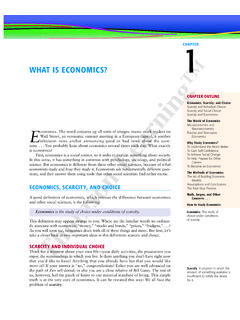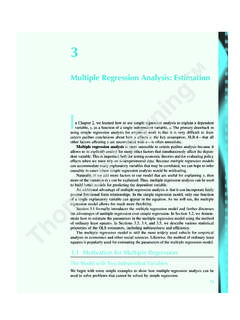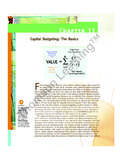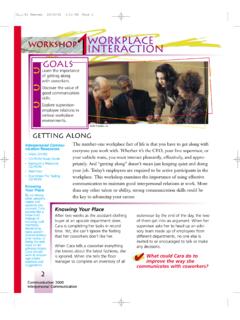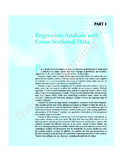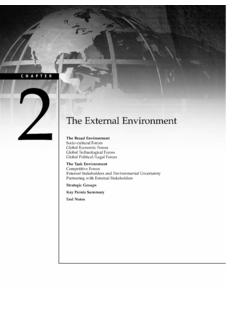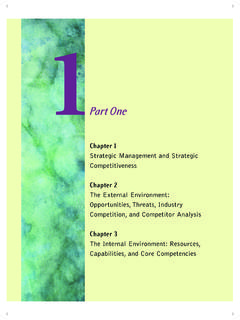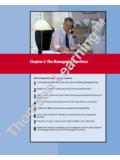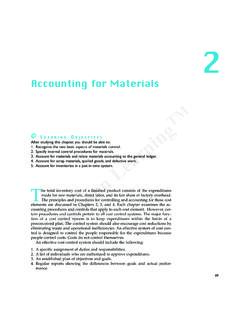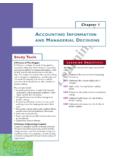Transcription of Auditing Revenue and Related Accounts - Cengage Learning
1 Thomson Learning 10 CHAPTERA uditing Revenue and Related AccountsThe overriding objective of this textbook is to build a foundation to analyze cur-rent professional issues and adapt audit approaches to business and economiccomplexities. Through studying this chapter, you will be able to:1 Explain the concept of accounting cycles and their impact on audit approaches, and identifythe Accounts in the Revenue the importance of proper Revenue recognition and the characteristics of Revenue - Related the major types of fraud and misstatements that have occurred in the Revenue how to use analytical procedures to identify possible misstatements in the inherent and control risk regarding Revenue cycle audit procedures to test the effectiveness of controls in the Revenue the auditor s control risk assessment to the development of substantive tests of accountsin the Revenue the factors that influence the effectiveness and efficiency of audits of account Auditing concepts to test Auditing concepts to test Accounts fraud indicators in the Revenue cycle and Related audit
2 The adequacy of a client s allowance for doubtful chapter illustrates the audit concepts developed in Chapters 4 through 9 by applying them tothe Accounts in the Revenue cycle. Sales transactions are always material to a company s financialstatements and often are subject to manipulation. Many audit failures have been characterized bymisstatement of sales. Because sales are often subject to misstatement, special attention is paid tothe control environment and to management s motivation to stretch accounting principles toachieve desired Revenue the auditor has assessed environment risk for each significant account balance and Related as-sertions, the audit program for testing account balances is finalized. At this stage of the audit, theauditor should have a good idea where and what types of misstatements might exist in the accountbalances.
3 The auditor must decide which audit procedures to perform, how extensively those proce-dures should be performed, and which Accounts and account items should be tested. This chapterdescribes the basic sales recording process, identifies the major documents and controls present inthat process, describes the types of Revenue - Related fraud, identifies approaches to assessing envi-ronment risk, and discusses the substantive audit procedures relevant to Revenue cycle OBJECTIVESCHAPTER OVERVIEWT homson Learning INTRODUCTIONAs discussed in Chapter 5, the auditor must assess the risk of material misstatements oc-curring and going undetected by the client s internal controls (environment risk). Themethodology for assessing inherent and control risks, including the testing of controls,and for determining the nature, timing, and extent of substantive testing of account bal-ances in the Revenue cycle are illustrated in this Cycle ApproachTypical accounting transactions follow a defined cycle.
4 For example, we tend to view thetransactions Related to Revenue to flow from an initial sale through to the collection ofthe proceeds from the cycle concept helps the auditor visualize both the incomeand balance sheet Accounts Related to most day-to-day transactions of the organizationand thus provides a convenient way to organize accounting transactions for audit testingand evaluation. We use the term cycle to refer to the processing of important transac-tions as these transactions update all the Related account balances associated with cycle transactions include all the processes ranging from the ini-tiation of a sales transaction to shipping a product, billing the customer, and collectingcash for the sale.
5 The nature of transactions vary with the organization, but most organ-izations process transactions that can be classified into the following cycles: Revenue Acquisition and payment of goods and services Payroll and Related compensation Financing: debt and capital Cash and short-term investments Companies will have other processes that may lend themselves to cycle-type characteri-zations as well. For example, a manufacturing company will likely have a process thattracks inventory costs through work in process to finished goods and finally to cost ofgoods sold. Most companies have processes Related to payroll that identify and recordtransactions for health-care benefits and cycle approach is one way, but notthe only way, to assist the auditor in focusing on all important account balances surround-ing a transaction to ensure that sufficient audit evidence is gathered, evaluated, and usedin reaching conclusions about the correctness of recorded of the Revenue CycleThe cycle concept presents a framework for viewing the interrelationship between ac-counts affected by the same transaction or business activity.
6 Audit evidence verifying theexistence and proper valuation of Accounts receivable also provides evidence of the exis-tence and valuation of recorded Revenue , and vice versa. When examining sales transac-tions, the auditor also gathers evidence on proper credit authorization and the proper val-uation of the recorded transactions . Further, a review of sales contracts provides evidenceto analyze the adequacy of the client s warranty expenses and Related transactions often serve as a basis for computing commissions for sales staff. Salesinformation is used for strategic long-term decision making and marketing ,the accuracy of accounting in the Revenue cycle is important for management decisionsas well as for the preparation of financial Accounts typically affected by sales transactions are shown in Exhibit Thesales process differs with each client, but the commonalities of the Revenue cycle can beused to develop audit programs for most organizations.
7 For example, a sale of a briefcaseIntroduction383LO1 The auditor must examine theprocess of recording transac-tions to help identify wherethe greatest risks of misstate-ments might Learning 384 Chapter 10 Auditing Revenue and Related Accountsin a department store differs from a sale of construction equipment, and both of thesediffer from a catalog sale of a lamp placed over the phone or Internet. Some organiza-tions generate paper-based sales documentation; others maintain an audit trail only incomputerized form. The control concepts are similar, but the means to implement anddocument the transactions control objectives in the Revenue cycle are the same as those developed in auditor should determine that the design of the system and the implemented con-trol procedures ensure that: All recorded transactions have occurred.
8 All of the transactions that took place are recorded. The transactions have been recorded accurately. The transactions have been recorded in the correct accounting period. The transactions have been recorded in the proper is not one set of control procedures that apply to all Revenue willdiscuss the types of controls the auditor should look for as we illustrate the diversity ofrevenue recording Cycle AccountsThomson Learning THEREVENUEACCOUNTINGSYSTEMMost sales transactions include the procedures and Related documents shown in But, with computerization, several of these procedures are combined. We use theterm documents to apply not only to paper documents, but also to electronic documentsthat provide evidence of the transaction and the responsibilities of each party to auditor will need to consider the nature of the document (electronic orpaper) to determine the specific controls and types of audit procedures needed to verifythe effectiveness of the control procedures.
9 For example, a customer s purchase order, thebill of lading (signed by a representative of the common carrier), and a turnaround doc-ument (on which the customer writes the amount of payment) are paper-based docu-ments with external validation attributes. On the other hand, a customer may have aIntroduction385 EXHIBIT of Sales ProcessThomson Learning 386 Chapter 10 Auditing Revenue and Related Accountscontract specifying prices and quantities of goods for a year. Instead of a paper purchaseorder, the customer might submit their planned production schedule electronically to thecompany for delivery on a just-in-time basis. Shipments may be delivered and unloadeddirectly into the production line with no bill of lading, and the customer might pay oncea month via electronic funds transfer based on production control objec-tives are the same in both the manual and electronic environment, but the audit ap-proaches and the control procedures differ ACUSTOMERPURCHASEORDERP rocessing begins with the receipt ofa purchase order from a customer or the preparation of a sales order by a might be taken by (1) a clerk at a checkout counter, (2) a salesperson making a callon a client, (3) a customer service agent of a catalog sales company answering a toll-freenumber, (4)
10 A computer receiving purchase order information electronically from the cus-tomer s computer, or (5) the sales department directly receiving the purchase order. Thenature and extent of documentation vary considerably. For example, among the order tak-ers just identified, it is possible that none of them will generate a paper sales order document should contain elements that provide a basis for determin-ing that all transactions are properly authorized and completely recorded. These controlprocedures include the use of prenumbered sales orders, documentation of authorization,formal approval for credit, a description of part number, sales price, and shipping termsof the products ordered, and an authorized billing if a sales order is not physically generated, the same information is recorded incomputerized form.
